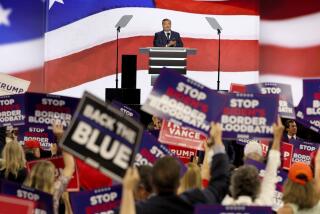Nation’s Violent Crime Rate Climbs 3.6%, FBI Reports : Law: The 1-year increase in California is 4.3%. Cities are worst hit, and a wave of juvenile offenses continues to grow.
- Share via
WASHINGTON — The nation’s violent crime rate rose 3.6% last year, to a total of 1.9 million reported offenses, the FBI said Saturday in an annual report.
In California, 331,122 violent crimes were reported in 1991, the report said, for an increase of 4.3% from the previous year.
The FBI also reported a continuing crime wave among juveniles. Over the decade ending in 1990, violent crime arrests of youths aged 10 to 17 grew by 27%.
The figures, based on records from 16,000 local law enforcement agencies, promptly stimulated a debate over the Bush Administration’s response to the problem.
U.S. Atty. Gen. William P. Barr noted that over the last 10 years the violent crime rate, which is based on the number of reported crimes per 100,000 population, has not risen as sharply as it did during the previous two decades. He attributed the slower rate of increase to tougher treatment of repeat offenders.
But Democratic Rep. Charles E. Schumer of New York, chairman of the subcommittee on crime of the House Judiciary Committee, said the new figures illustrate the Administration’s “total inability to deal with the crime problem.” Schumer accused the White House of opposing gun-control legislation because of pressure from the National Rifle Assn.
The FBI reported that for all age groups, the rate of violent crimes--murders, rapes, robberies and aggravated assaults--increased by 24% from 1987 to 1991.
The rate of violent crime was highest in the nation’s cities, which registered 1,015 offenses for every 100,000 population. The rate in suburban counties was 470 per 100,000, while in rural counties, 214 violent crimes were reported per 100,000.
Barr called the 1991 figures “unacceptably high,” but said he found comfort that the increases over the last 10 years “are significantly lower than in the previous two decades.”
He noted that “the violent crime rate increased by 126% between 1960 and 1970 and by 64% between 1970 and 1980, but only 22.7% between 1980 and 1990.”
This, he said, “makes clear that the imprisonment of chronic violent offenders has a dramatic positive effect on the amount of violent crime,” drawing the parallel that “in the 1960s and early 1970s incarceration rates fell and crime rates skyrocketed.”
By contrast, said Barr, “when incarceration rates increased substantially in the 1980s, the rate of increase of crime was substantially reduced.”
However, Schumer said the new figures “clearly illustrate the Administration’s total inability to deal with the crime problem.”
“People are scared,” said Schumer, “and these tragic numbers show that they have every right to be. This report proves that the carnage in the streets continues to get worse despite all the tough talk from the Administration.”
He said FBI figures showing that seven out of 10 murders are committed with firearms demonstrates the need for the Administration to support the so-called Brady bill, passed by the House last year, to impose controls over handgun purchases.
Barr and Schumer also drew different conclusions from the violent crime rate among juveniles.
Barr said the trend “clearly shows that we must enact wholesale reform of the juvenile justice system so that for the vast majority of juvenile offenders, their first brush with the law is their last, and that the small group of chronic, hardened, youthful offenders are incapacitated for extended periods.”
But the long-term solution, he said, “falls largely outside of the law enforcement system. It requires strengthening those basic institutions--the family, schools, religious institutions and community groups--that are responsible for instilling values and creating law-abiding citizens.”
Schumer said the sharp rise in violent crimes committed by juveniles “clearly illustrates another area where the Administration’s efforts have been totally lacking.”
He said Administration officials have proposed “radical cuts in funding for juvenile justice programs, and they do not support a provision in the crime bill that would guarantee early intervention and certainty of punishment for juvenile and youthful offenders.”
The FBI report gave statistics for juvenile crimes over the decade 1980 to 1990, but did not provide figures for individual years.
The juvenile crime rate overall--including violent acts as well as nonviolent burglary, larceny-theft and auto theft offenses--was higher for white youth than for minorities. The rate for white youths rose 44% during the decade, compared to a 19% increase among black youths and a decline of 53% in other racial groups. However, in the category of violent crimes, the rate for black youths was five times that of whites.
The number of youths of all races who committed murder using guns was up 79% in the decade.
Other items from the report:
--Firearms were the weapons used in 31% of all murders, robberies and assaults, an increase from 1987 when firearms figured in 26% of all cases.
--A total of 718,890 people were arrested for violent crimes last year, of which 54% were white.
--A total of 14.2 million arrests were made for non-traffic offenses in 1991, down 1% from 1990. Of those arrested, 46% were under 25, 81% were male and 69% were white.
--Murders totaled 24,703 in 1991, or one for every 10,000 Americans.
Of the victims, 78% were male, 89% were 18 or older, 50% were black and 47% were white. Nearly half knew their assailants; 28% of female victims were killed by husbands or boyfriends.
Of the 24,578 people charged with murder, 90% were male and 87% were over 18. Fifty-five percent were black and 43% white.
--Eighty-three of every 100,000 females were reported to be rape victims last year, up 3% from 1990 and 13% from 1987.
--Property crimes numbered 13 million in 1991, up 1% from the previous year. Losses totaled $16.1 billion.
More to Read
Sign up for Essential California
The most important California stories and recommendations in your inbox every morning.
You may occasionally receive promotional content from the Los Angeles Times.













